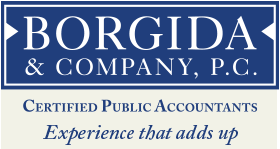Local Manchester, CT CPA firm Borgida & Company warns clients about missing making payments for estimated taxes and IRS penalties.
The Surprise Bill Coming to Those Who Underpay Their Taxes-
The IRS penalty for shortfalls jumps to 8%
By Ashlea Ebeling, Wall Street Journal, Dec. 2, 2023 9:00 pm ET
Failing to keep up with payments for estimated taxes now could lead to an expensive surprise come next spring.
As of Oct. 1, the Internal Revenue Service is charging 8% interest on estimated tax underpayments, up from 3% two years ago.
The increase is one of the many effects of rising interest rates.
These higher penalties, which can run in the hundreds or even thousands of dollars, are particularly relevant for gig workers and consultants who don’t have taxes withheld and figure they can pay their taxes come April. People who get steady paychecks with tax withholding could also be affected if they have additional income and get the math wrong.
For most taxpayers, their employer withholds taxes in every paycheck, with the majority due for a tax refund for having overpaid. Still, the IRS assessed more than $1.8 billion in penalties for underpaying estimated taxes on nearly 12.2 million individual returns in fiscal year 2022.
Beyond underpayment penalties, the higher total tax bills for millions of Americans increase the risk that many won’t be able to pay their full balance in April. Failing to pay all of your tax bills can lead to more penalties and—in the worst case—IRS collection actions including liens and levies.
“It’s a cautionary tale for individuals to think about as we get toward year-end. Are you where you should be?” said Joseph Doerrer, a certified public accountant and certified financial planner at Mezzasalma CPAs in Tinton Falls, N.J.
The U.S. tax system is pay-as-you-go, meaning you should make payments as you earn income. That can be done through withholding or by making quarterly — or even more frequent — tax payments during the year.
To avoid underpayment penalties, most filers must pay 90% of their taxes through withholding during the calendar year, or through estimated payments due quarterly. The payment for the fourth quarter of 2023 comes due Jan. 16, 2024. The IRS won’t charge an underpayment penalty if the balance due is less than $1,000 after taking into account withholding and credits. (Though it is called a penalty, it is essentially interest tied to the federal short-term rate.)

Staying on top of estimated taxes s is especially important for people with fluctuating or self-employment income. Taxpayers with bonuses and equity compensation, whereby automatic tax withholding is too low, could face underpayment penalties. Anyone with higher-than-usual interest from high-yield savings accounts and mutual-fund dividend or capital-gain distribution payouts could also be affected.
One common scenario in which taxpayers get tripped up is when wage earners who are used to having tax withholding by an employer start a business. They might not know that they are subject to quarterly estimated tax payments.
The first year Sameet Durg, a marketing executive in Warren, N.J., went to Doerrer to do his taxes, it turned out he owed an underpayment penalty in the thousands of dollars — on top of a big April tax bill — because he hadn’t made estimated payments to cover his consulting income.
“Now I pay attention to taxes all year around. I don’t want the giant hit in April,” Durg said, noting he checks in with Doerrer monthly.
Here’s how to keep your tax payments on track.
Avoid underpayment penalties. A gig worker who owes $10,000 in taxes and didn’t make quarterly estimated payments of $2,500 would face a $512 underpayment penalty, along with his tax bill on April 15, said Chris Oliva, a CPA at UHY Advisors in New York City. The penalty calculation, figured on Form 2210, uses a blended interest rate for tax year 2023.
Individual taxpayers can generally insulate themselves from underpayment penalties by paying in (through withholding or estimated taxes) at least 90% of the current-year tax bill or 100% of the previous year’s tax bill. The 100% figure rises to 110% for filers with adjusted gross income of more than $150,000, or $75,000 for married taxpayers filing separately.
It makes sense to toggle between the two methods if your income is uneven, said Doerrer.
If you have a high-income year followed by a low-income year, you would want to pay in at 90%. Otherwise, you would be making an unnecessarily large overpayment, Doerrer said. If you have a low-income year followed by a high-income year, it can make sense to pay 100% or 110% of the prior year’s income tax, keeping estimated. taxes lower and anticipating a larger balance due in April.
Try the IRS tax-withholding estimator. To use the IRS tax-withholding estimator, taxpayers need to plug in information from their last year’s tax return, pay stubs and all other income, including side gigs, investments and retirement account payouts.
If you have a pension but not a job, use Form W-4P to estimate your withholding. IRS Publication 505 has worksheets and examples for taxpayers in special situations.
https://www.wsj.com/personal-finance/taxes/federal-tax-withholding-estimates-penalty-2023-e6c3736f


